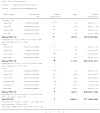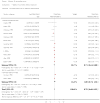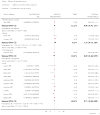Selenium for preventing cancer
- PMID: 21563143
- PMCID: PMC3692366
- DOI: 10.1002/14651858.CD005195.pub2
Selenium for preventing cancer
Update in
-
Selenium for preventing cancer.Cochrane Database Syst Rev. 2014 Mar 30;2014(3):CD005195. doi: 10.1002/14651858.CD005195.pub3. Cochrane Database Syst Rev. 2014. Update in: Cochrane Database Syst Rev. 2018 Jan 29;1:CD005195. doi: 10.1002/14651858.CD005195.pub4. PMID: 24683040 Free PMC article. Updated.
Abstract
Background: Selenium is a trace element essential to humans. Higher selenium exposure and selenium supplements have been suggested to protect against several types of cancers.
Objectives: Two research questions were addressed in this review: What is the evidence for1. an aetiological relationship between selenium exposure and cancer risk in women and men?2. the efficacy of selenium supplementation for cancer prevention in women and men?
Search strategy: We searched electronic databases and bibliographies of reviews and included publications.
Selection criteria: We included prospective observational studies to answer research question (a) and randomised controlled trials (RCTs) to answer research question (b).
Data collection and analysis: We conducted random effects meta-analyses of epidemiological data when five or more studies were retrieved for a specific outcome. We made a narrative summary of data from RCTs.
Main results: We included 49 prospective observational studies and six RCTs. In epidemiologic data, we found a reduced cancer incidence (summary odds ratio (OR) 0.69 (95% confidence interval (CI) 0.53 to 0.91) and mortality (OR 0.55, 95% CI 0.36 to 0.83) with higher selenium exposure. Cancer risk was more pronouncedly reduced in men (incidence: OR 0.66, 95% CI 0.42 to 1.05) than in women (incidence: OR 0.90, 95% CI 0.45 to 1.77). These findings have potential limitations due to study design, quality and heterogeneity of the data, which complicated the interpretation of the summary statistics.The RCTs found no protective efficacy of selenium yeast supplementation against non-melanoma skin cancer or L-selenomethionine supplementation against prostate cancer. Study results for the prevention of liver cancer with selenium supplements were inconsistent and studies had an unclear risk of bias. The results of the Nutritional Prevention of Cancer Trial (NPCT) and SELECT raised concerns about possible harmful effects of selenium supplements.
Authors' conclusions: No reliable conclusions can be drawn regarding a causal relationship between low selenium exposure and an increased risk of cancer. Despite evidence for an inverse association between selenium exposure and the risk of some types of cancer, these results should be interpreted with care due to the potential limiting factors of heterogeneity and influences of unknown biases, confounding and effect modification.The effect of selenium supplementation from RCTs yielded inconsistent results. To date, there is no convincing evidence that selenium supplements can prevent cancer in men, women or children.
Conflict of interest statement
GD: None known
MZw: None known
MB: None known
MV: None known
MZe: Maurice Zeegers is the first investigator of one included observational study and one ongoing randomised controlled trial. He is second author of another included observational study.
MH: None known
Figures


























Comment in
-
[Does selenium protect against cancer?].Dtsch Med Wochenschr. 2011 Aug;136(34-35):1709. doi: 10.1055/s-0031-1286350. Epub 2011 Aug 29. Dtsch Med Wochenschr. 2011. PMID: 21877300 German. No abstract available.
References
References to studies included in this review
-
- Akbaraly NT, Arnaud J, Hininger-Favier I, Gourlet V, Roussel AM, Berr C. Selenium and mortality in the elderly: results from the EVA study. Clinical Chemistry. 2005;51(11):2117–23. - PubMed
-
- Allen NE. Reply to B bekaert and MP rayman. American Journal of Clinical Nutrition. 2009;89(4):1277. - PubMed
- Allen NE, Appleby PN, Roddam AW, Tjonneland A, Johnsen NF, Overvad K, et al. Plasma selenium concentration and prostate cancer risk: results from the European Prospective Investigation into Cancer and Nutrition (EPIC) American Journal of Clinical Nutrition. 2008;88(6):1567–75. - PubMed
-
- Bleys J, Navas-Acien A, Guallar E. Serum selenium levels and all-cause, cancer, and cardiovascular mortality among US adults. Archive of Internal Medicine. 2008;168(4):404–10. - PubMed
-
- Brooks JD, Metter EJ, Chan DW, Sokoll LJ, Landis P, Nelson WG, et al. Plasma selenium level before diagnosis and the risk of prostate cancer development. The Journal of Urology. 2001;166(6):2034–8. - PubMed
-
- Clark L, Graham G, Bray J. Nonmelanoma skin cancer and plasma selenium: a prospective cohort study. American Journal of Epidemiology [Abstracts of papers presented at the eighteenth annual meeting of the Society For Epidemiologic Research; Chapel Hill, North Carolina. June 19–21, 1985; 1985. p. 528.
References to studies excluded from this review
-
- Bostick RM, Potter JD, McKenzie DR, Sellers TA, Kushi LH, Steinmetz KA, et al. Reduced risk of colon cancer with high intake of vitamin E: the Iowa Women’s Health Study. Cancer Research. 1993;53(18):4230–7. - PubMed
-
- Brock KE, Gridley G, Morris JS, Willett WC. Serum selenium level in relation to in situ cervical cancer in Australia. Journal of the National Cancer Institute. 1991;83(4):292–3. - PubMed
-
- Chen Q. [Protective effects of selenium, zinc and copper on lung cancer]. Zhonghua Yu Fang Yi Xue Za Zhi [Chinese Journal of Preventive Medicine] 1988;22(4):221–4. - PubMed
-
- Chen K, Qiu JL, Sui LM, Yu WP, Wang JY, Zhang LJ. Nutrient intake and gastric cancer in residents of Zhoushan Islands, China. Digestive and Liver Disease. 2003;35(12):912–3. - PubMed
References to ongoing studies
-
- Nomura AM. [accessed 12 January 2004];5R01CA033644-19. Cancer sero epidemiology among the Japanese in Hawaii. http://crisp.cit.nih.gov/
-
- Cheng KK. [accessed 16 April 2004];ISRCTN38534743. Selenium supplementation for the prevention of hepatocellular carcinomas in HBsAg positive patients (pilot study) http://www.controlled-trials.com/isrctn/trialprint-friendly.asp?ISRCTN=3....
-
- Cheng KK. [accessed 18 February 2009];ISRCTN13889738. Bladder Cancer Prognosis Programme (incorporating SELENIB trial) http://www.controlled-trials.com/mrct/trial/232573/selenib.
-
- Eastern Cooperative Oncology Group. [accessed 6 April 2011];Selenium in preventing tumor growth in patients with previously resected stage I non-small cell lung cancer. http://clinicaltrials.gov/ct2/show/NCT00008385.
- Eastern Cooperative Oncology Group. ECOG-5597. Phase III randomized chemoprevention study of selenium in participants with previously resected stage I non-small cell lung cancer. Eastern Cooperative Oncology Group; [accessed 6 April 2011]. http://www.cancer.gov/clinicaltrials/featured/trials/ecog-5598.
- Karp DD. Phase III chemoprevention trial of selenium supplementation in persons with resected stage I non-small-cell lung cancer. Clinical Advances in Hematology and Oncology. 2005;3(4):313–5.
-
- Clark LC, Marshall JR. Randomized, controlled chemoprevention trials in populations at very high risk for prostate cancer: elevated prostate-specific antigen and high-grade prostatic intraepithelial neoplasia. Urology. 2001;57(4 Suppl 1):185–7. - PubMed
- Coltman CA. [accessed 12 January 2004];5U01CA077178-06. Selenium based chemoprevention. http://crisp.cit.nih.gov/
- Marshall J, Jarrard D, Lee WR. [accessed 16 April 2004];SWOG-S9917. Phase III randomized study of selenium as chemoprevention of prostate cancer in patients with high-grade prostatic intraepithelial neoplasia. http://clinicaltrials.gov/
- Marshall JR. Larry Clark’s legacy: randomized controlled, selenium-based prostate cancer chemoprevention trials. Nutrition and Cancer. 2001;40(1):74–7. - PubMed
- Marshall JR, Sakr W, Wood D, Berry D, Tangen C, Parker F, et al. Design and progress of a trial of selenium to prevent prostate cancer among men with high-grade prostatic intraepithelial neoplasia. Cancer Epidemiology, Biomarkers & Prevention. 2006;15(8):1479–84. - PubMed
- Nelson MA, Reid M, Duffield-Lillico AJ, Marshall JR. Prostate cancer and selenium. The Urologic clinics of North America. 2002;29(1):67–70. - PubMed
- South West Oncology Group. [accessed 16 April 2004];NCT00030901. Selenium in preventing cancer in patients with neoplasia of the prostate. http://clinicaltrials.gov/
Additional references
-
- Alfthan G, Neve J. Selenium intakes and plasma selenium levels in various populations. In: Kumpulainen JT, Salonen JT, editors. Natural antioxidants and food quality in atherosclerosis and cancer prevention. Cambridge: The Royal Society of Chemistry; 1996. pp. 161–7.
-
- Arnaud J, Arnault N, Roussel AM, Bertrais S, Ruffieux D, Galan P, et al. Relationships between selenium, lipids, iron status and hormonal therapy in women of the SU.VI.M.AX cohort. Journal of Trace Elements in Medicine and Biology. 2007;21(Suppl 1):66–9. - PubMed
-
- Ashton K, Hooper L, Harvey LJ, Hurst R, Casgrain A, Fairweather-Tait SJ. Methods of assessment of selenium status in humans: a systematic review. American Journal of Clinical Nutrition. 2009;89(6):2025S–39S. - PubMed
-
- Barany E, Bergdahl IA, Bratteby LE, Lundh T, Samuelson G, Schutz A, et al. Trace elements in blood and serum of Swedish adolescents: relation to gender, age, residential area, and socioeconomic status. Environmental Research. 2002;89(1):72–84. - PubMed
-
- Bjelakovic G, Nagorni A, Nikolova D, Simonetti RG, Bjelakovic M, Gluud C. Meta-analysis: antioxidant supplements for primary and secondary prevention of colorectal adenoma. Alimentary Pharmacology & Therapeutics. 2006;24(2):281–91. - PubMed
Publication types
MeSH terms
Substances
Grants and funding
LinkOut - more resources
Full Text Sources
Other Literature Sources
Molecular Biology Databases

